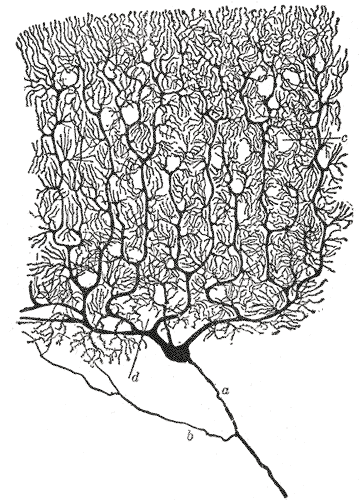I have two sweeties in school right now pursuing postgraduate degrees related in some way to neuroscience, brain mapping, or brain modeling.
Brain mapping is hard. Really, really, really hard.
It’s not just that there’s a lot of neurons in the brain (though there are–about 100 billion1 or so). It’s not just that they’re wired together in beastly complicated ways, though that, too, is true.
It’s that “beastly complicated” doesn’t even begin to cover it.
This is a drawing of a type of brain cell called a Purkinje cell, taken from a 1918 copy of Gray’s Anatomy. 1918! We’ve known about these things for a long time:

There are a lot of these in your brain, mostly in your voluntary motor control areas. A single Purkinje cell has one axon, which is basically a nerve cell’s output, and as many as 200,000 dendrites, which are basically a nerve cell’s input. Purkinje cells regulate motor control, primarily by inhibiting other neurons from firing. All your motor control is mediated by these brain cells. They’re also hooked into “climbing fibers,” axons from other neurons which pass from the center parts of your brain outward.
At rest, these guys fire regularly, sending inhibitory signals to neurons deeper down. When activated, they fire much more rapidly, more strongly inhibiting downstream neurons. All well and good, but…
…a single Purkinje cell can have two hundred thousand inputs. Read that again so that the pure horror has time to sink in. A single Purkinje cell can have two hundred thousand inputs.
So, if you were to, say, want to map a person’s brain, that would basically mean recording each brain cell and a list of all the other brain cells it links to. If you had 100 brain cells and each one could link to one other cell, you’d have, potentially, 100 links to record. If you had 100 brain cells and each one could link to 10 other cells, you’d have 100 times 10, or 1,000, links to record. If you had 100 brain cells and each could link to 20 other cells, you’d have 100 times 20 links to record. Makes sense, right?
And if you have 100 billion cells, and each cell can link to 200,000 other cells, you have 100,000,000,000 times 200,000 links to record.
This is a really, really, really big number. This is the kind of number that’s within the same order of magnitude as the number of grains of sand on the entire freaking planet. Imagine tagging, isolating, and recording the relative position of every freaking grain of sand on the entire freaking planet and you’ll start to gain an appreciation of the magnitude of the challenge involved in mapping a human brain.
Even your own DNA doesn’t record this information–it can’t. If you were to dedicate the entire information storage capacity of the entire human genome just to mapping the connections between all your brain cells, you’d fall short by several orders of magnitude. The process of building a brain is dynamic; your DNA only describes the gross physical structure, and then as your brain forms it wires itself up more or less randomly2. That’s why it takes such a long time to make a human brain–a process that isn’t really finished ’til you’re out of puberty3.
Which is very depressing, when you consider just how valuable that model will be. And makes my sweeties all the more amazing, I think.
1 American billion (1×109), not British billion (1×1012).
2 Well, not really randomly,, but not deterministically according to a blueprint either. Each nerve cell sends out dendrites, which hook up with whatever nearby nerve cells they happen to hook up with–a neuron that fails to hook up to any other neurons typically dies. The direction and number of dendrites are determined, in general ways, by your genes, but the specific connections that get made are not. And these connections remain dynamic throughout your entire life; long term memory, for example, appears to be encoded in patterns of connections.
3 Interestingly, most of the late-stage development, that takes place during and just after puberty, is inhibitory. Kinda explains a lot, doncha think?
